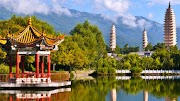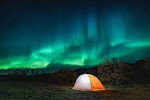Historical Travel: Saigon and Angkor Wat
All set for our New Year's escape to Vietnam and Cambodia!
Have you been on a foreign trip where your main purpose is to learn from the country's history?
Have you been on a foreign trip where your main purpose is to learn from the country's history?
It has been my fascination to travel not just for leisure and see those state-of-the-art structures and highly-developed surroundings but to gain knowledge by discovering other places' rich cultural heritage.
Two of Asia's historical countries that seem do not appeal to millennials and to people who like modern environment are Vietnam and Cambodia, both had troubled past and disturbing history. With depraved economic reputations and nothing but temples, pagodas, palace ruins and countryside scenery, most people naturally never considered Vietnam and /Cambodia as ideal holiday destinations.
But I don't travel just for fun and leisure, I travel for discovery and additional learning, both countries have so many things to offer when it comes to cultural discoveries. And yes, nature tripping.
Here are the places and landmarks I am planning to explore.
Here are the places and landmarks I am planning to explore.
1. Saigon (now Ho Chi Minh City)
Formerly, the capital of the French colony of Cochinchina, Ho Chi Minh city currently is the largest city in Vietnam and the most advanced when it comes to industrial improvement compared to the country's capital, Hanoi. This is located in Southern Vietnam, very far from Hanoi but closer to Cambodia, Thailand and Laos.
The popular West End musical, Miss Saigon, is based on the story of a Vietnamese girl named Kim who had fallen in love with an American soldier during Vietnam War, paving a story that would match the star-crossed lover theme of Romeo and Juliet. Saigon is the focal point of the Vietnam war. Today, the remnants of the war are very much alive in Saigon through its museums, ruins and tunnels. It is also called the Paris of the Orient due to the city's French colonial structures.
According to my research around the web, these are the best attractions to visit in Saigon:
Reunification Palace - Impressive building design and home to the President of Southern Vietnam during the American War also known as Vietnam War.
War Remnants Museum - Features the memories of Vietnam War with weapons used during the war are still on display. Visitors will know here the war-torn-history of the country.
History Museum - French colonial building built in 1929, surrounded by lush botanical garden.The museum showcases the centuries-old Vietnamese culture and history
Central Post Office - Has been in existence since 1886 and would you believe this was designed by Gustave Eiffel the designer of Eiffel Tower in France?
Notre Dame Cathedral - Very European structure reminiscent to most cathedrals in France and Italy, this is a Neo-Romanesque architectural style built at the end of 19th century by French colonists.
Jade Emperor Pagoda - Saigon's most spectacular temple according to many travelers who had visited Vietnam.
City Hall - Beautiful French architecture and the garden surrounding the building is simply awesome based on the photos I saw around the web.
Saigon Opera House - Amazing French colonial architecture, located just within Lam Son Square in District 1.
Suo Tien Themed Park - The largest amusement park in Vietnam and signifies what amusement is all about according to online sources. It combines amazing elements of a wonderland and bizarre facilities of a haunted house. The park details Vietnamese culture with Buddha and temples dominating the landscape of the park.
Ben Thanh Market - Public market and food stalls located in District 1.
2. Phnom Pehn City, Cambodia
We will be crossing Cambodia on January 3 and dropping by at Phnom Pehn City, the country's capital, en-route to Angkor Wat. We booked a hotel near the Royal Palace so that we can take a quick visit on the day of our arrival. Hope to explore also the Killing Fields center which showcases the atrocities and brutalities of the Khmer Rouge during the bloodiest reigns of the Khmer Empire rulers.
3. Siem Reap City
This is where the Angkor Wat is nearly located. No hotels available around Angkor Wat so we will be staying for one night at a Siem Reap hotel.
4. Angkor Wat
The ultimate national symbol of Cambodia, Angkor Wat highlights the example of an ancient Khmer architecture, it features one of the most stunning architectural achievements of humankind. In Khmer, Angkor Wat means "City of Temples" which sounds true as the whole place is composed of pagodas and temples. Angkor Wat according to its web profile is a Buddhist temple and the largest religious complex in the world!
Angkor Wat itself has a gripping history attached to its massive complex. It was built in the 12th century instigated by a Khmer King, Suryavarman II, who came to power after he killed his great uncle. When the King built the temple, it was intended to be dedicated to Vishnu, one of the trinities of Hinduism, it became a Buddhist temple only in 14th century.
Angkor Wat is one of the world's most visited places and its temples are the most astonishing works of architecture. Set on 200 hectares of land, Angkor Wat is surrounded with moat, towers, clusters of temples and evocative paintings and sculptures, a must-see for history and culture fanatics. Truly a wonderful place that would never be missed! It is a UNESCO's World Heritage site.
Angkor Wat is probably one of Asia's greatest places to explore when talking about history and culture. It is quite far from Phnom Pehn city, about five hours, so we are planning to take a mini bus service instead which cuts the hours of travel compared when riding a public bus.
So many things to explore, so many things to discover, what a good start to welcome the year 2015!
Formerly, the capital of the French colony of Cochinchina, Ho Chi Minh city currently is the largest city in Vietnam and the most advanced when it comes to industrial improvement compared to the country's capital, Hanoi. This is located in Southern Vietnam, very far from Hanoi but closer to Cambodia, Thailand and Laos.
Reunification Palace in Saigon
One of the French colonial architectural highlights in the city
According to my research around the web, these are the best attractions to visit in Saigon:
Reunification Palace - Impressive building design and home to the President of Southern Vietnam during the American War also known as Vietnam War.
War Remnants Museum - Features the memories of Vietnam War with weapons used during the war are still on display. Visitors will know here the war-torn-history of the country.
History Museum - French colonial building built in 1929, surrounded by lush botanical garden.The museum showcases the centuries-old Vietnamese culture and history
Central Post Office - Has been in existence since 1886 and would you believe this was designed by Gustave Eiffel the designer of Eiffel Tower in France?
Notre Dame Cathedral - Very European structure reminiscent to most cathedrals in France and Italy, this is a Neo-Romanesque architectural style built at the end of 19th century by French colonists.
Jade Emperor Pagoda - Saigon's most spectacular temple according to many travelers who had visited Vietnam.
City Hall - Beautiful French architecture and the garden surrounding the building is simply awesome based on the photos I saw around the web.
Saigon Opera House - Amazing French colonial architecture, located just within Lam Son Square in District 1.
Suo Tien Themed Park - The largest amusement park in Vietnam and signifies what amusement is all about according to online sources. It combines amazing elements of a wonderland and bizarre facilities of a haunted house. The park details Vietnamese culture with Buddha and temples dominating the landscape of the park.
Ben Thanh Market - Public market and food stalls located in District 1.
2. Phnom Pehn City, Cambodia
We will be crossing Cambodia on January 3 and dropping by at Phnom Pehn City, the country's capital, en-route to Angkor Wat. We booked a hotel near the Royal Palace so that we can take a quick visit on the day of our arrival. Hope to explore also the Killing Fields center which showcases the atrocities and brutalities of the Khmer Rouge during the bloodiest reigns of the Khmer Empire rulers.
3. Siem Reap City
This is where the Angkor Wat is nearly located. No hotels available around Angkor Wat so we will be staying for one night at a Siem Reap hotel.
4. Angkor Wat
The ultimate national symbol of Cambodia, Angkor Wat highlights the example of an ancient Khmer architecture, it features one of the most stunning architectural achievements of humankind. In Khmer, Angkor Wat means "City of Temples" which sounds true as the whole place is composed of pagodas and temples. Angkor Wat according to its web profile is a Buddhist temple and the largest religious complex in the world!
Aerial view of Angkor Wat
Angkor Wat itself has a gripping history attached to its massive complex. It was built in the 12th century instigated by a Khmer King, Suryavarman II, who came to power after he killed his great uncle. When the King built the temple, it was intended to be dedicated to Vishnu, one of the trinities of Hinduism, it became a Buddhist temple only in 14th century.
Angkor Wat is one of the world's most visited places and its temples are the most astonishing works of architecture. Set on 200 hectares of land, Angkor Wat is surrounded with moat, towers, clusters of temples and evocative paintings and sculptures, a must-see for history and culture fanatics. Truly a wonderful place that would never be missed! It is a UNESCO's World Heritage site.
Angkor Wat is probably one of Asia's greatest places to explore when talking about history and culture. It is quite far from Phnom Pehn city, about five hours, so we are planning to take a mini bus service instead which cuts the hours of travel compared when riding a public bus.
So many things to explore, so many things to discover, what a good start to welcome the year 2015!
UPDATE:
CLICK BELOW LINKS FOR MY ACTUAL TRAVEL EXPERIENCE TO CAMBODIA AND VIETNAM:
















0 Comments